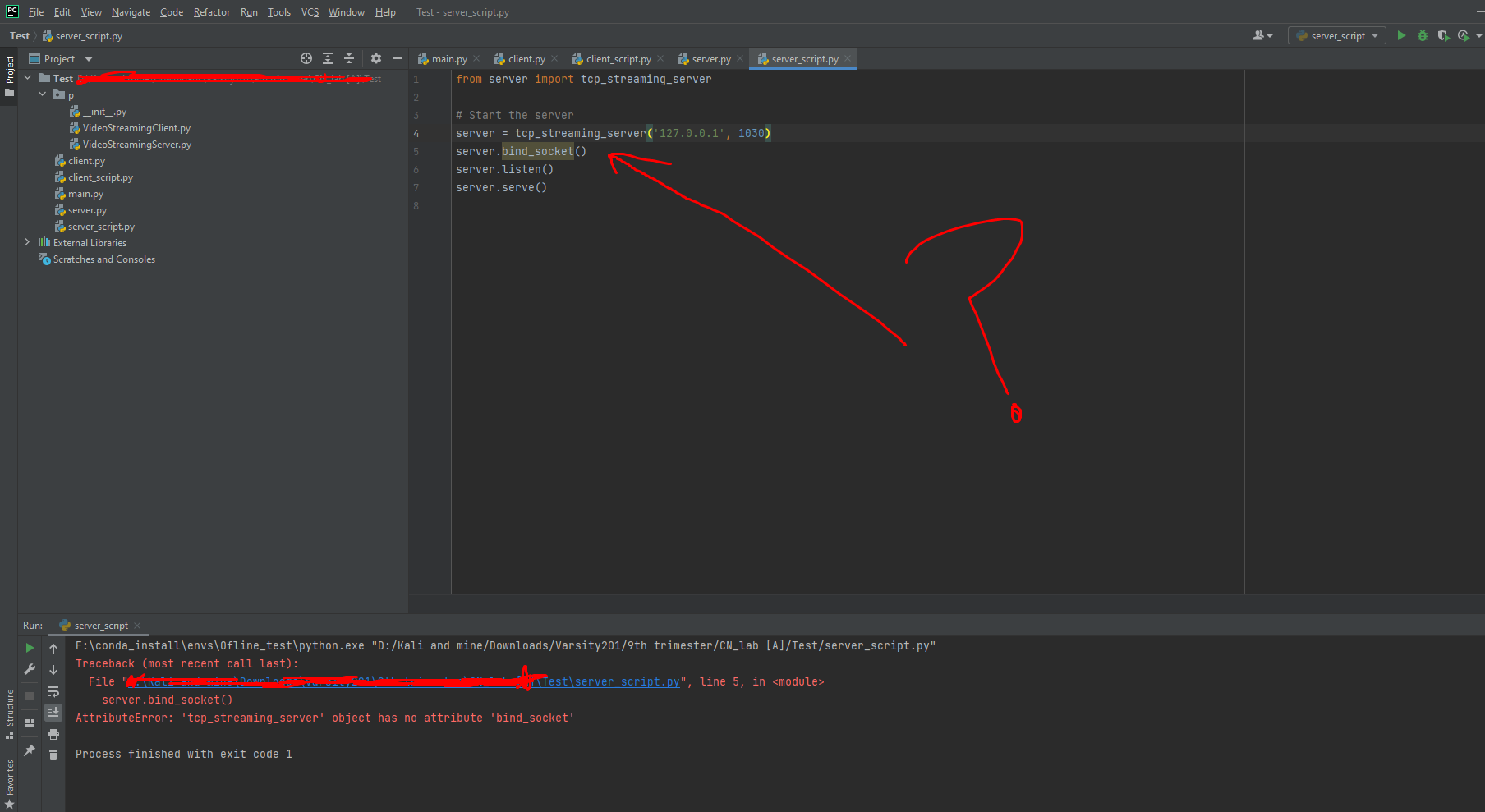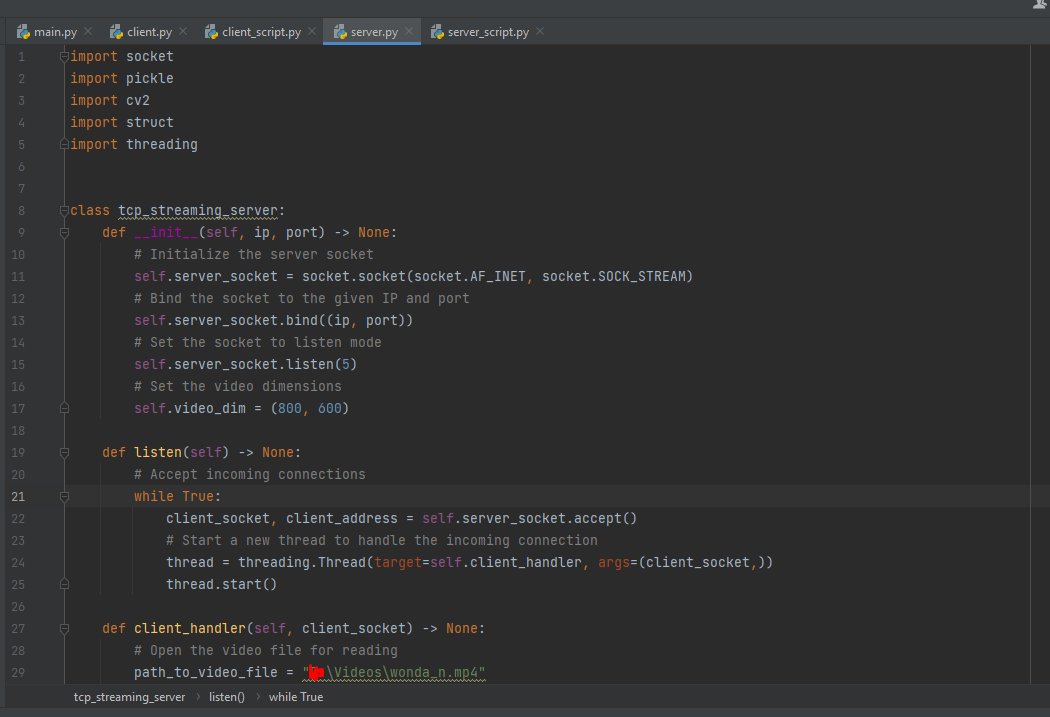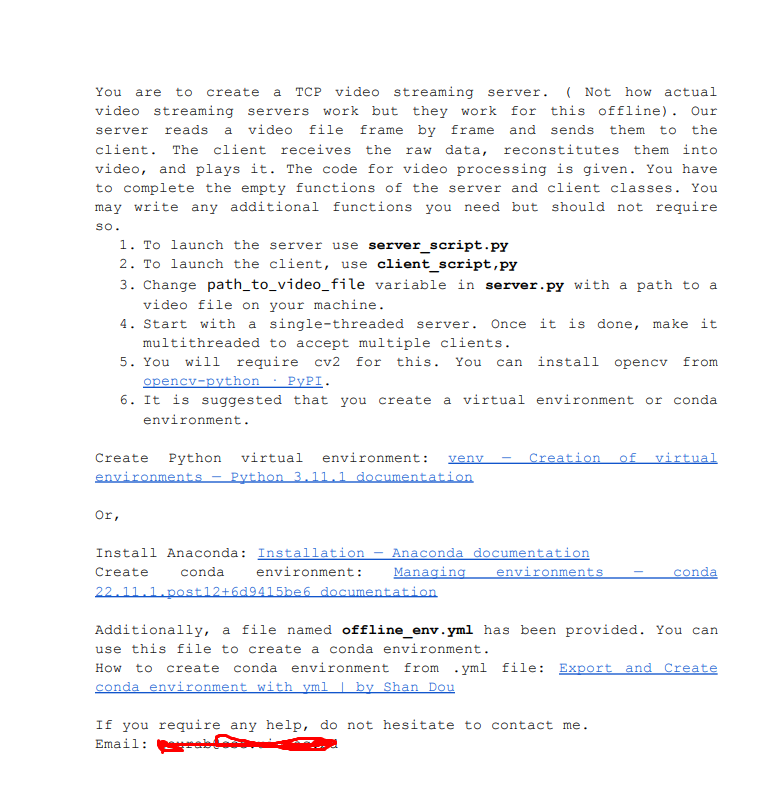Answered step by step
Verified Expert Solution
Question
1 Approved Answer
_____________________@@_____________________@@_____________________@@ Why am I having this error can you please help and write it correctly? here is the complete code: setup with Conda environment. _____________________@@_____________________@@_____________________@@


_____________________@@_____________________@@_____________________@@
Why am I having this error can you please help and write it correctly?
here is the complete code: setup with Conda environment.
_____________________@@_____________________@@_____________________@@
@@@_______________________client.py_______________________@@
import socket import struct import cv2 import pickle class client: def __init__(self, server_ip, server_port) -> None: # Initialize the client socket self.client_socket = socket.socket(socket.AF_INET, socket.SOCK_STREAM) # Connect to the server self.client_socket.connect((server_ip, server_port)) def receive_video_data(self) -> None: data = b"" try: # Unpack the payload size (Q = unsigned long long) payload_size = struct.calcsize("Q") while True: # Receive the serialized frame size packed_msg_size = self.client_socket.recv(payload_size) # If there is no data, break the loop if not packed_msg_size: break # Unpack the serialized frame size msg_size = struct.unpack("Q", packed_msg_size)[0] # Receive the serialized frame in chunks while len(data)
@@@_______________________client_script.py_______________________@@
import cv2 from client import client # Connect to the server client = client('127.0.1.1', 1030) client.connect_to_server() # Receive and display the video data client.receive_video_data() # Release the video display window cv2.destroyAllWindows() @@@_______________________server.py_______________________@@
import socket import pickle import cv2 import struct import threading class tcp_streaming_server: def __init__(self, ip, port) -> None: # Initialize the server socket self.server_socket = socket.socket(socket.AF_INET, socket.SOCK_STREAM) # Bind the socket to the given IP and port self.server_socket.bind((ip, port)) # Set the socket to listen mode self.server_socket.listen(5) # Set the video dimensions self.video_dim = (800, 600) def listen(self) -> None: # Accept incoming connections while True: client_socket, client_address = self.server_socket.accept() # Start a new thread to handle the incoming connection thread = threading.Thread(target=self.client_handler, args=(client_socket,)) thread.start() def client_handler(self, client_socket) -> None: # Open the video file for reading path_to_video_file = "D:\Videos\wonda_n.mp4" vid = cv2.VideoCapture(path_to_video_file) try: # Read the video frame by frame while vid.isOpened(): _, frame = vid.read() # Resize the frame to the desired dimensions frame = cv2.resize(frame, self.video_dim, fx=0, fy=0, interpolation=cv2.INTER_CUBIC) # Serialize the frame using pickle serialized_frame = pickle.dumps(frame) # Pack the length of the serialized frame as an unsigned long long (Q) # and prepend it to the serialized frame message = struct.pack("Q", len(serialized_frame)) + serialized_frame # Send the serialized frame to the client client_socket.sendall(message) except: # If any error occurs, close the client socket client_socket.close() def serve(self) -> None: try: # Accept incoming connections and start a new thread for each one self.listen() except KeyboardInterrupt: self.server_socket.close() @@@_______________________server_script.py_______________________@@
from server import tcp_streaming_server # Start the server server = tcp_streaming_server('127.0.0.1', 1030) server.bind_socket() server.listen() server.serve()
Question:

server_script tcp_streaming_server > listen0 > while True You are to create a TCP video streaming server. ( Not how actual video streaming servers work but they work for this offline). Our server reads a video file frame by frame and sends them to the client. The client receives the raw data, reconstitutes them into video, and plays it. The code for video processing is given. You have to complete the empty functions of the server and client classes. You may write any additional functions you need but should not require so. 1. To launch the server use server_script.py 2. To launch the client, use client_script,py 3. Change path_to_video_file variable in server.py with a path to a video file on your machine. 4. Start with a single-threaded server. Once it is done, make it multithreaded to accept multiple clients. 5. You will require cv2 for this. You can install opencv from opencv-python : PyPI. 6. It is suggested that you create a virtual environment or conda environment. Create Python virtual environment: venv - creation of virtual environments - Python 3.11.1 documentation Or, Install Anaconda: Installation - Anaconda documentation Create conda environment: Managing environments - conda 22.11.1.post 12+6 d94.15be6 documentation Additionally, a file named offline_env.yml has been provided. You can use this file to create a conda environment. How to create conda environment from .yml file: Export and create conda environment with yml b by Shan Dou If you require any help, do not hesitate to contact me. Email Step by Step Solution
There are 3 Steps involved in it
Step: 1

Get Instant Access to Expert-Tailored Solutions
See step-by-step solutions with expert insights and AI powered tools for academic success
Step: 2

Step: 3

Ace Your Homework with AI
Get the answers you need in no time with our AI-driven, step-by-step assistance
Get Started


